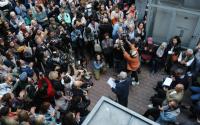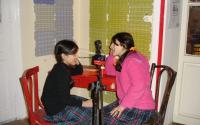21 May 2007Steve Hymon
In case you missed the news, Mayor Antonio Villaraigosa and a selected posse from the City Council traveled by bus to Debs Park in northeast L.A. last week to announce how they're going to lasso global warming. The gist of the plan is for the city government and its residents to burn a lot less fossil fuels in 2030 than they did in 1990. Fossil fuels produce carbon dioxide, the heat-trapping gas that is the chief culprit behind climate change.The second-best moment of the news conference came when Villaraigosa introduced Councilman Dennis Zine. The mayor already had lauded the green credentials of the other council members but could think to praise Zine only for having joined his colleagues on several unanimous votes on environmental issues — and for sometimes riding a motorcycle.And the best moment of the news conference?Upon its conclusion, when Villaraigosa climbed into his black GMC Yukon SUV and motored back to his Windsor Square home. Villaraigosa and the council members had arrived earlier aboard a chartered DASH bus. Look at us! We like mass transit! As for the GMC Yukon, imagine an oversize Darth Vader's helmet with a tailpipe. The U.S. Environmental Protection Agency rates it as getting about 17 miles per gallon and producing 10.6 tons of greenhouse gases a year.To put that in perspective, a Toyota Prius puffs out 3.4 tons of greenhouse gases a year.Mayoral press secretary Janelle Erickson said the bus was arranged for logistical reasons and that the mayor was using the vehicle that his security staff has asked him to use. This demonstrates the difficulty of being an elected official — you get kicked by the media either way. If Villaraigosa had shown up in a Prius, for example, this column would bark his shins because he usually drives a Yukon.A happy ending could be in the works. A hybrid version of the Yukon is due out later this year, with a 25% improvement in fuel efficiency, General Motors says.What else is really interesting about the climate plan?First, making inroads on the city's habit of belching carbon dioxide may be easier for the mayor than tackling the schools. Ironic, eh?As for the climate plan, it doesn't say much about higher power rates or higher taxes or fees to help pay for clean energy or more mass transit to get people out of their cars. In other words, the plan stressed the gains to be made through technology rather than the gains from people changing their behavior. "If you start by telling them" global warming requires a "catastrophic program, and they are the cause of it, you find that people dig in their heels and turn off the conversation right there," said John Healy, a spokesman for Seattle's Office of Sustainability and Environment. Still, Seattle has shown the willingness to use the stick, in addition to the carrot. Under Mayor Greg Nickels, the city passed a commercial parking tax last year to give people one more reason not to drive and to help pay for more mass transit. It's hard to imagine making serious, meaningful gains without some politician having to lower the boom on taxpayers and ratepayers between now and 2030. And it will be intriguing to see who that politician is.What's interesting about Villaraigosa's appointment of Ernesto Cardenas, brother of Councilman Tony Cardenas, to the Board of Public Works?Villaraigosa and Tony Cardenas have a long history going back to their days together in the state Assembly in the 1990s. But the two men have never been terribly close. Public Works board seats long have been viewed as political rewards, because the job pays $115,090 annually.As it happens, the mayor's budget for the coming fiscal year — which focuses on anti-gang efforts — may be voted on as early as today by the council. And who is the chairman of the council's gang prevention committee that wants to hold off funding some of the mayor's new anti-gang programs until he can vet them in his committee?If you guessed Tony Cardenas, treat yourself to an extra Pop-Tart.What was that smell coming into City Hall on Thursday?The city's parks department spreading manure all over the south lawn.Isn't manure loaded with nitrogen that washes into the city's storm drains and then the Los Angeles River?Yes.Haven't the feds ordered Los Angeles to clean up nitrogen in the river?Yes.Returning to the subject of relocating Dodger Stadium, what did a 1990 study conclude about the current ballpark?Attentive readers may recall this column's offhandedly proposing a few weeks ago that a gondola be built connecting Chinatown to the stadium.As it turns out, that very notion was studied in 1990 by the old Los Angeles County Transportation Commission, which eventually was folded into the Metropolitan Transportation Authority. Thanks to reader David Louie, a commercial real estate broker and El Pueblo commissioner, for sending us the study. The commission at the time was exploring ways to connect the Chinatown station for the proposed L.A.-to-Pasadena light-rail line to the stadium. Among the options considered were a gondola, increased bus service, a light-rail extension, a monorail and a combination of pedestrian escalators and walkways.The conclusion: "Many people could reach the station on foot faster than they could be conveyed by transit," the study said.The problem with the other options was that they were expensive, and crowds would overwhelm them before and after the game.That meant, for example, it would take 92 minutes to get to the stadium on the gondola. As for the money, the study found the monorail would be efficient but would have cost $25 million compared to less than $5 million for the escalator plan. Obviously, the study never went anywhere, and the Dodgers, under their various owners, never have pursued it. Why should they, with all that parking revenue coming in?So we asked Louie — who also has served on the city's Planning Commission — what he thought about a stadium in downtown.His answer: Some change is inevitable. Either Frank McCourt, the Dodgers owner, will develop the parking lots around the stadium, with the stadium as the centerpiece, or the team eventually will move, Louie believes.McCourt has told his lenders he will keep the team in Dodger Stadium for 25 years. Maybe that will hold up. This column notes that the majority of Major League teams have moved into new stadiums in the last decade or soon will do so. Things change.Louie also floated a novel idea: putting a stadium over the tracks at Union Station — one way to make it transit friendly.Meanwhile, downtown blogger Eric Richardson has posed the same question to readers of his blogdowntown.com site. He also created a website, http://www.cartifact.com/stadium , that allows visitors to "move" the stadium around town.One interesting idea floated on Richardson's blog puts the new stadium on Alameda Street near the future Little Tokyo station of the Gold Line extension. Union Station is a short walk.And guess who owns some of the land there? The city of Los Angeles. Now about those buildings in the way…. Next week: Fixing the city's housing crisis in 25 words or less.






